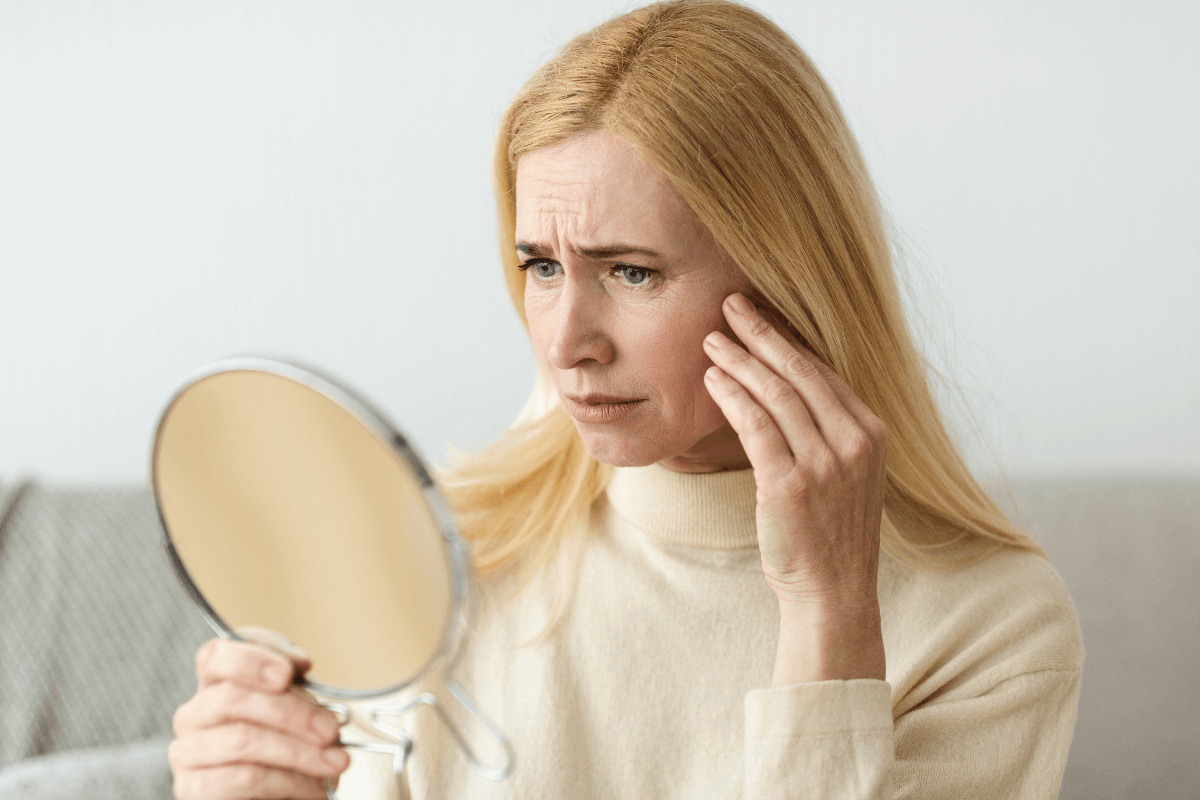Some people notice facial changes informally called Mounjaro face. The term usually refers to facial volume loss after significant weight reduction on tirzepatide. It blends biology and optics: less subcutaneous fat (the under‑skin layer) changes contours, while skin elasticity and hydration influence how visible it looks.
Key Takeaways
- Weight-loss driven changes: Rapid fat loss can slim cheeks and temples.
- Not a listed adverse reaction: Labels emphasize gastrointestinal effects, not facial volume loss.
- Modifiable risks: Slower titration, protein intake, and resistance training may help.
- Treatment options: Fillers and skin therapies can restore contours when appropriate.
What Is Mounjaro face and Why It Happens
Mounjaro (tirzepatide) is a dual GIP/GLP‑1 receptor agonist that helps regulate appetite and glucose. When weight drops quickly, subcutaneous adipose tissue (fat beneath the skin) also declines. The face can show this change early because small volume shifts alter light and shadow across cheeks, temples, and the jawline. That optical contrast often makes normal fat loss look more dramatic than it is.
Skin elasticity matters. With age, collagen and elastin production slow, and skin may not recoil as well. Dehydration, low protein intake, and high sun exposure can accentuate hollowing. These factors do not mean damage to facial tissues from the medicine itself; rather, they reflect how weight change interacts with facial anatomy and skin quality.
How Common Is It? What We Know from Data
Clinical trials and product labels emphasize gastrointestinal Side Effects of Mounjaro such as nausea and diarrhea. Facial volume loss is not listed as a distinct adverse reaction on the tirzepatide label. That difference matters because it frames the issue as a consequence of weight reduction rather than a direct drug toxicity to facial tissues.
Observational reports vary, but the phenomenon appears tied to the amount and speed of weight change. Real‑world experiences differ because age, baseline BMI, and skin health vary widely. If you’re troubleshooting tolerability or tempo, see Minimize Mounjaro Side Effects for practical escalation strategies and supportive care ideas. For label‑level safety context, the FDA prescribing information focuses on metabolic indications and known adverse reactions.
Discuss Mounjaro side effects with your clinician when they affect daily function or wellbeing. A tailored plan can balance weight‑management benefits with appearance concerns.
Recognizing Facial Changes: Signs, Photos, and Timeline
Common signs include flatter cheeks, slight temple hollowing, and sharper jawlines. Skin can look looser if elasticity is reduced, especially after larger or faster weight changes. Lighting, angles, and expressions often exaggerate or minimize these differences, so use consistent conditions to track progress over time.
Many people compare progress images for motivation, but Ozempic Rebound resources can help you frame long‑term expectations and avoid weight cycling that can alter contours again. When reviewing mounjaro face before and after pictures, note camera distance, smiling, and makeup. Consistent weekly photos, measured body composition, and waist circumference provide a clearer, less biased view of change.
Risk Factors and Who Is More Likely
Several factors increase visibility of facial slimness. Older age, prior sun damage, or smoking can reduce collagen and elastin. Faster weight loss, low protein intake, and minimal resistance training may reduce muscle and soft‑tissue support. Genetics and baseline fat distribution also play important roles in how cheeks, temples, and under‑eye areas appear during weight reduction.
Some people without diabetes use tirzepatide for obesity management under medical supervision. Differences in baseline insulin resistance, dietary patterns, and pacing can influence appearance changes. If you are evaluating mounjaro side effects for non diabetics, align goals with sustainable nutrition and strength training. For broader strategy ideas, browse Weight Management articles to plan progressive, maintainable habits.
Prevention and Mitigation: Lifestyle and Medication Strategy
Three habits help maintain facial support: adequate protein, resistance training, and steady hydration. Aim for protein at each meal to support collagen and lean mass. Two to three weekly strength sessions can preserve muscle and improve facial tone indirectly. Prioritize sleep and sun protection because both affect skin quality, texture, and perceived laxity.
Medication strategy matters. If weight is falling very quickly, talk with your prescriber about holding a dose, extending intervals, or pausing escalation. These adjustments can moderate the rate of change without guessing. For nutrition and body‑composition tactics during GLP‑1 therapy, see Diet and GLP-1 Weight Loss for evidence‑informed ideas. If you wonder how long does mounjaro side effects last, timelines vary with dose, individual sensitivity, and supportive habits.
Dermatologic and Aesthetic Options
If appearance changes bother you, non‑surgical procedures can help. Hyaluronic acid fillers restore volume temporarily, while biostimulatory fillers (such as poly‑L‑lactic acid) encourage collagen over months. Energy‑based devices can improve skin firmness by stimulating dermal remodeling. These tools require trained, licensed clinicians and realistic expectations about subtle, gradual gains.
Dermal Fillers and Biostimulatory Options
Fillers can address cheeks, nasolabial folds, and temples with tailored placement. Biostimulatory products gradually thicken the dermis by spurring collagen production. Plan sessions around stable weight and a predictable medication schedule. Discuss bruising risk, infection precautions, and contraindications with your provider. For an overview of filler indications and safety basics, see MedlinePlus dermal fillers from the National Library of Medicine. If you are exploring how to avoid mounjaro face through aesthetics, start with a conservative plan and reassess after weight stabilizes.
It’s also helpful to distinguish injection‑related tissue changes elsewhere. For example, localized fat buildup at injection sites is a different process—see What Is Lipohypertrophy for how and why that occurs—and it does not explain facial hollowing.
Comparisons: Related Medications and Outcomes
Tirzepatide is indicated for type 2 diabetes and chronic weight management under different brand names. Cosmetic changes linked to weight loss can appear with other incretin‑based therapies as well. For mechanism and outcomes differences, compare class peers and dosing frameworks before changing therapy.
People sometimes weigh Zepbound vs Mounjaro when focusing on obesity versus glycemic control. For product specifics, see Zepbound, and for semaglutide‑based comparators, review Ozempic Semaglutide Pens along with the methods in Wegovy vs Mounjaro. Label‑level safety and class effects are detailed in the Zepbound prescribing information and the tirzepatide label.
Safety, Thyroid Warnings, and When to Seek Care
Tirzepatide carries a boxed warning for thyroid C‑cell tumors in rodents; avoid use with a personal or family history of medullary thyroid carcinoma or MEN2. Pancreatitis, gallbladder disease, and severe gastrointestinal symptoms warrant medical evaluation. New neck masses, persistent hoarseness, or unexplained dysphagia require prompt assessment.
If you are researching mounjaro side effects thyroid, review the FDA label and discuss personal risk factors with your clinician. The tirzepatide label also outlines interactions and contraindications. For broader metabolic planning, explore Type 2 Diabetes resources that cover comprehensive risk reduction strategies beyond weight alone.
What To Do Next: A Practical, Neutral Checklist
– Track change consistently: same lighting, angle, and facial expression.
– Support tissues: prioritize protein, resistance training, hydration, and sun protection.
– Moderate tempo: discuss dose timing and escalation pace if loss is rapid.
– Consider aesthetics: consult licensed dermatology or aesthetic medicine if changes distress you.
– Reassess goals: ensure diet quality and activity plans remain sustainable long term.
For device or pen formats, review Mounjaro KwikPen Pre Filled Pen details to understand administration options. Keep expectations realistic and aligned with metabolic health priorities.
Recap
Facial changes during tirzepatide therapy typically reflect healthy fat loss showing first in an expressive, low‑volume area—the face. Thoughtful pacing, nutrition, and strength training can soften the effect. When needed, skilled aesthetic care can restore balance safely and gradually.
This content is for informational purposes only and is not a substitute for professional medical advice.


